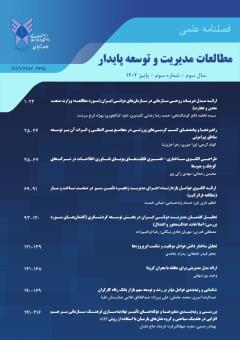تحلیل ساختار دانش عوامل موفقیت و شکست ابرپروژهها
محورهای موضوعی : سایر موضوعات مرتبط
جعفر قیدر خلجانی
1
![]() ,
پدرام جاهدی
2
,
پدرام جاهدی
2
![]()
1 - دانشیار مهندسی صنایع، گروه مهندسی صنایع، مجتمع دانشگاهی مدیریت و مهندسی صنایع، دانشگاه صنعتی مالک اشتر، تهران، ایران.
2 - دکتری، گروه مدیریت بازرگانی، دانشکده مدیریت و حسابداری، دانشگاه علامه طباطبائی، تهران، ایران.
کلید واژه:
چکیده مقاله :
ابرپروژه لفظی برای تشخیص پروژههای راهبردی از پروژههای عادی است. ابرپروژه نیازمند تخصیص منابع زیاد و دارای پیامدهای تحولآفرین است. پژوهشهای زیادی برای شناسایی مصداقی عوامل موفقیت و شکست ابرپروژهها انجام شدهاست. هدف این پژوهش تحلیل ساختار دانش عوامل موفقیت و شکست ابرپروژهها است. پژوهش از نظر هدف کاربردی است. جامعه آماری پژوهش محتوای نمایه شده مرتبط با عوامل موفقیت و شکست ابرپروژهها در وبگاه علم، روش نمونهگیری قضاوتی و حجم نمونه 3728 است. راهکنش تحلیل دادههای پژوهش شامل تحلیل ساختار بافت و تحلیل ساختار محتوا است. تحلیل ساختار بافت شامل گامهای فهرستسازی، مرتبسازی، مصورسازی و تحلیل دادههای زمینهای و تحلیل ساختار محتوا شامل دو مرحله استخراج دادههها و کدگذاری است. تحلیل ساختار بافت مؤید روند صعودی نمایهسازی، جریان غالب معرفی یک کشور بهعنوان سکوی ابرپروژه و سهم نمایهسازی بیشتر حوزه مدیریت پروژه است. تحلیل ساختار محتوا نیز موجب شناسایی 277 کد، 177 مفهوم، 101 زیرمقوله، 69 مقوله و 9 بُعد شده است. این بُعدها شامل موفقیت و شکست ابرپروژهها، زمینه، حوزه، تیمهای ابرپروژه، چرخه عمر ابرپروژه، سرمایهگذاری، محیط، طرفین درگیر و عوامل اجتماعی است. پراکندگی نظری در گزینش واژگان نشاندهنده نیاز به همگرایی در گزینش واژگان و ضرورت شناسایی چهارچوبهای نظری از محتوای نمایهشده مرتبط با موفقیت و شکست ابرپروژهها است.
Megaproject is a term used to distinguish strategic projects from normal projects. The super project requires the allocation of many resources and has transformative consequences. Much research has been done to identify the success and failure factors of megaprojects. This research aims to analyze the knowledge structure of the success and failure factors of megaprojects. Research is practical in terms of purpose. The statistical population of the indexed content research related to the success and failure factors of megaprojects in science websites, the judgmental sampling method, and the sample size are 3728. The method of research data analysis includes the analysis of the structure of the context and the analysis of the content structure. Contextual structure analysis includes the steps of cataloging, sorting, illustrating, and contextual data analysis, and content structure analysis includes two steps of data extraction and coding. The analysis of the texture structure confirms the upward trend of indexing, the dominant flow of introducing a country as a megaproject platform, and the greater contribution of indexing to the field of project management. Analysis of the content structure has identified 277 codes, 177 concepts, 101 subcategories, 69 categories, and 9 dimensions. These dimensions include the success and failure of megaprojects, context, domain, super project teams, super project life cycle, investment, environment, involved parties, and social factors. The theoretical dispersion in the selection of vocabulary indicates the need for convergence in the selection of vocabulary and the necessity of identifying theoretical frameworks from the indexed content related to the success and failure of megaprojects.


